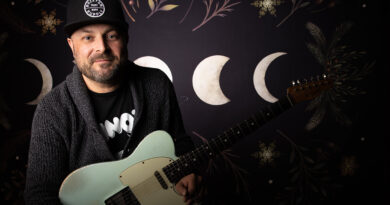Different Alternate Guitar Tunings – Guitar Noise
Changing the tuning on your guitar can make it seem like a whole new instrument, and in a way it almost is. By changing the notes that we can pluck, it will alter our shapes, chords, and final sound that is created. To get ideas for more tunings we can look at other instruments, music genres, and even playing styles of musicians who couldn’t even read music. So grab an online guitar tuner and check out these different alternate guitar tunings and what they can be used for.
What Is Tuning?
When you are learning about tuning in your beginner guitar lessons, it can be helpful to look at a piano keyboard, the guitar fretboard is overlapping and confusing. The spaces between the notes are called intervals and they each have unique sound qualities. When we build scales, chords, or tunings the final vibe will be determined by the note spacing. Standard guitar tuning starts at the E2 octave and is EADGBE. Now if we count those intervals between the notes E-A, A-D, D-G, and B-E they are a fourth apart.
Not only are these fourth intervals common in modern rock and blues they also make it easier to form the guitar chords we need. Notice not all the notes are a fourth apart, the G-B is a third, this is to make it even easier to form modern pop chords. Standard tuning is that way because it fits with most blues, rock, dance, R&B, and metal. By altering our tuning we can start to create new sounds depending on what we do to our intervals.
Popular Alternate Guitar Tunings
One of the most common tunings is a half-step down at EbAbDbGbBbEb, each string lowered by one semitone. This has been seen often especially in the alternative and grunge music of the 90’s onward. It helps singers who are normally flat and it can have a deeper and fuller sound. Or if you want even more depth you can tune a whole step down at DGCFAD, and your chords will have to be adjusted accordingly. These tunings are nice as its easier to figure out new chords with the same shapes.
Another way to add depth is to drop our tunings, Drop D is DADGBE and gives us a 5-1-5 interval for a power chord on our three bass strings. These dropped tunings are going to be popular in styles like hard rock, metal, and progressive. Of course with just one string change the new chord shapes will not be the same. Next we can drop our D down a whole step to Drop C at CGCFAD, or maybe Drop B at BGbBEAbDb, and even Drop A at AEADF#B.
Now these dropped tunings are deep and heavy but some are not possible without the right gauge in string. Guitars can only have so heavy a string before the tone is destroyed so you may be limited on how low you can drop based on your guitar specs. So far we have been lowering most of our notes and intervals at the same time but we can also change them to an open chord.
An open tuning for guitar makes it so you can just strum the strings with nothing fretted and you will form a chord. The most common are open G DGBGBD or open D with DADF#AD as they are heard in folk and blues and those tunings make it a lot easier to play slide guitar. When you know you have an open chord it’s just a matter of hitting the right fret.
There is also open C CGCGCE and open E like EBEG#BE but be careful with any open tunings that make you tune upwards. Most of the time a half or whole step up may be safe but be careful as too much may lead to string breaks. Just like going too low if you go too high the tone or strings may be harmed. There are also raised tunings just as dropped and its best to stay within the lower amount to avoid damage.
More Alternate Guitar Tunings
You can tune your guitar to any chord you want and the underlying sonic qualities will carry over. A C6 is a less stable chord that is often associated with Hawaiian music, if we tune our guitar to it at CEGACE we will get those same vibes. Or a Dsus4 doesn’t give us any major or minor feel so if we use that tuning of DADGAD we will have a perfect feeling for folk and Celtic like music. The point to remember is that you have to see what new chords you have access to with the new tuning.
For reference, take a look at this guitar chord chart to understand your basic shapes.
Above we mentioned how standard tuning had all fourths except for the G-B, we can have an all fourths tuning of EADGCF or even an all major thirds of EG#CEG#C which will make for some repeated patterns. All fifths tuning is CGDAEB and will give you an interval approach like a violin or mandolin player. Some guitarists find these tunings to create a better atmosphere for learning the guitar fretboard notes, or at the very least they provide new ideas.
There are many lists online of various open, dropped, modal, cross, and more tunings available. The best way to study them is to understand the intervals and chords they build. When you know what vibe the tuning produces it will be easier for you to use it in your own music. By knowing your music theory you can essentially build your own tunings that will cater to your style and approach. Here are a few more random ones to try, just be mindful of how much the note changes with the string gauge.
Nick Drake liked odd ones like CGCFCE
F#F#GGAA
Joni Mitchell used AbAbEbAbCEb
Open D5 is DADADD
BF#BGBE
DADFAE
EBEEBE
CACGCE
DAEAEE
And if you find yourself completely bored by the tunings mentioned here it may be time to look into microtonal or fretless guitars. If you have done all the dropped and alternate tunings out there then it is time to start playing beyond semitone intervals, there are way more music styles than just Western music. However to access them it will be necessary to get a microtonal fretboard.
There are many different tunings to the guitar and what you pick will alter the final sound and vibe of the music. Depending on the genre and style of music that you want will determine which of the tunings you will use above. Play as many songs as you can and look up guitar tabs and chords to get an idea of what tunings bands use. Always be sure to follow the intervals, scales, and chords, if so the music theory will make sense and the fretboard will be so much easier to navigate in any tuning you choose.
By Shawn Leonhardt for Guitar Tricks and 30 Day Singer



